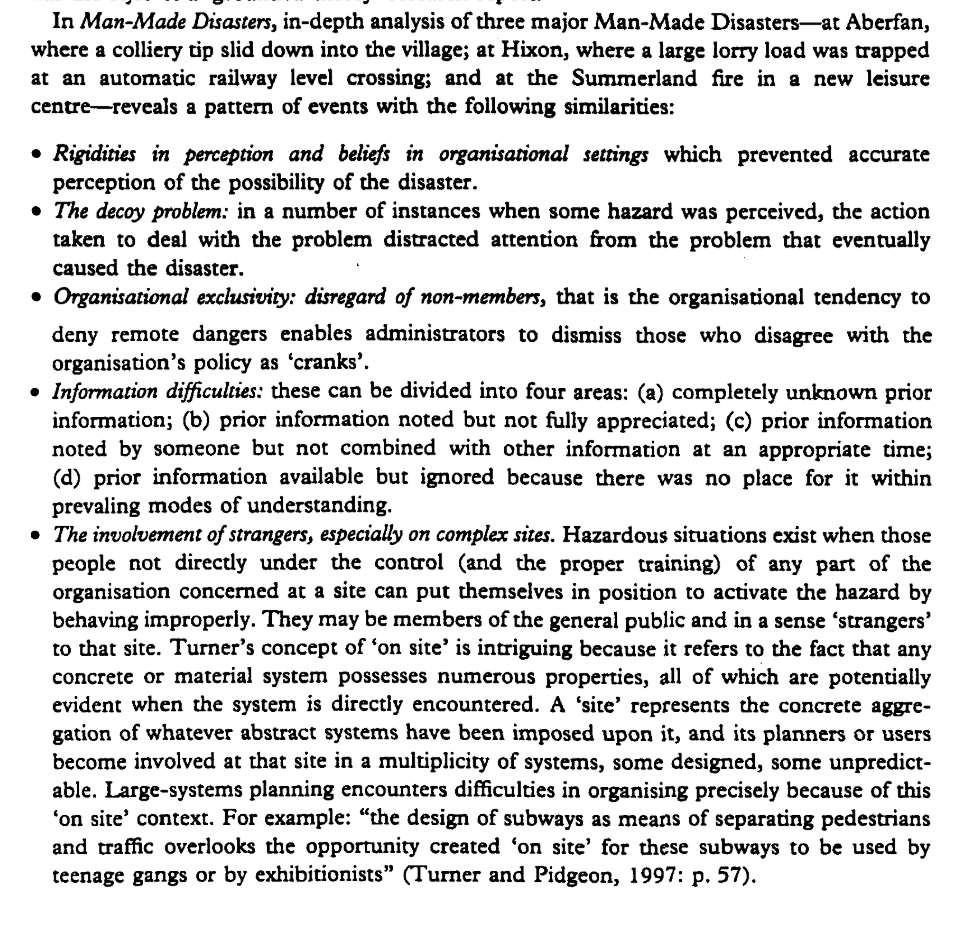
Another paper from the Barry Turner files from 1999, reflecting on the then 20 year period since Turner published his seminal work (this paper was written after his passing).
Based on Turner’s analysis on the incubation of disasters:
· Rigidities in perceptions and beliefs about what is and isn’t counted as a hazard. For instance, at the time of the Aberfan disaster, the “pervasive” beliefs and practices in UK coal mining was almost exclusively about underground hazards and not surface issues (like the surface waste tip that eventually collapsed)
· Decoy problem where focus on managing other issues and hazard distracted focus away from the issue that substantially contributed to or enabled the disaster
· Breakdowns in information (covered in a prior post, so skipped here)
· Minimising emergent danger, where signals of impending danger are denied or delayed due to various sociopolitical factors

· Failures of foresight, allowing accidents to incubate over time, driven by erroneous assumptions, cultural lag, and a reluctance or inability to envisage the worst outcome
· Individuals are said to rarely be in a position to create major disasters, since its organisations that have access to the necessary energy and resources to create disaster

· They talk about the role of organisational cultures, subcultures in disaster – where sometimes a culture can be “a way of seeing (which) is also a way of not seeing”
· While culture allows a way of ‘seeing’ and responding to the world, it can also be a “collective blindness to important issues, the danger that some vital factors may be left outside the bounds of organisational perception”

· Organisations also can inadvertently amplify the effects misunderstanding or misinformation in a way “which is far beyond the capabilities of any individual”
· They discuss the BSE crisis (mad cow disease) in the context of Turner’s sequence of events in a disaster. They highlight how the crisis started as a veterinary issue, then a beef industry concern, to a public health issue, to a symbol of fatality

· Most interesting in my view is that disaster in Turner’s context was more around the sociological view of ‘disaster’. Not so much by its energy or destruction, but of the sudden collapse of existing cultural assumptions about safety, danger and vulnerability, and “the collapse of precautions which had hitherto been culturally accepted as adequate”

Ref: Silvia Gherardi, B. A. Turner, N. E. Pidgeon & S. C. Ratzan (1999) Man-Made Disasters 20 years later: Critical commentary, Health, Risk & Society, 1:2, 233-239
Study link: https://doi.org/10.1080/13698579908407022
My site with more reviews: https://safety177496371.wordpress.com
One thought on “Man-Made Disasters 20 years later: critical commentary”